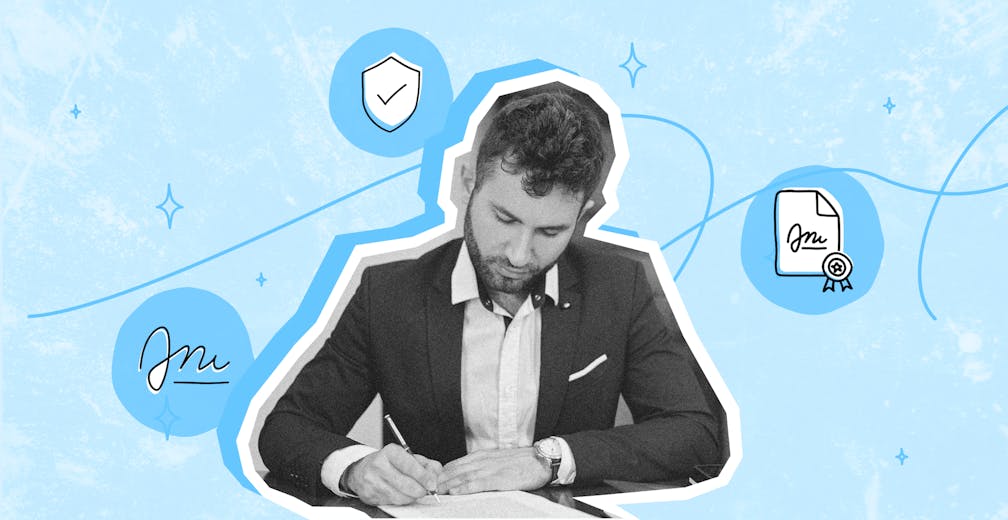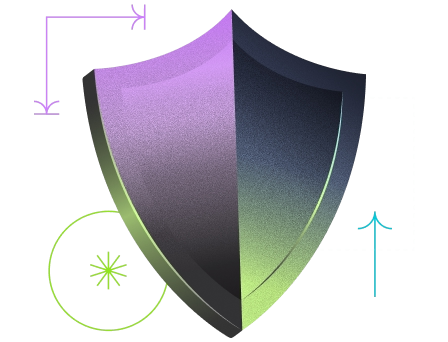In today's digital business environment, securing contracts and legal documents electronically has become essential. Among the three levels of electronic signatures defined by the eIDAS regulation, the Advanced Electronic Signature (AES) strikes the perfect balance between security, usability, and legal compliance.
Whether you're handling employment contracts, supplier agreements, or client onboarding, understanding AES can help you choose the right signing solution while ensuring legal enforceability. This guide explains what makes an electronic signature "advanced," how it works, when to use it, and how it compares to other signature types.
If you're looking for a legally secure and user-friendly signing process, AES offers a robust solution that meets the needs of most business transactions.
Brief summary:
- Definition: An Advanced Electronic Signature (AES) is a secure digital signature that uniquely identifies the signer and detects any document changes.
- Legal Requirements: AES must be uniquely linked to the signer, capable of identifying them, created under their sole control, and linked to signed data in a tamper-evident way.
- Use Cases: Ideal for B2B contracts, employment agreements, NDAs, financial approvals, and any document requiring strong legal assurance.
- Advantages: Combines high security with ease of use, offers strong evidentiary value, and meets most regulatory requirements.
- Compliance: Recognized across the EU and UK under eIDAS, with similar frameworks in the US (ESIGN Act, UETA) and other jurisdictions.
What Is an Advanced Electronic Signature (AES)?
An Advanced Electronic Signature represents the middle tier of electronic signatures under European law, offering significantly more security and legal weight than a Simple Electronic Signature (SES) while remaining more accessible than a Qualified Electronic Signature (QES).
AES Definition Under eIDAS Regulation
According to Article 26 of the eIDAS Regulation (EU) No 910/2014, an Advanced Electronic Signature is defined by specific technical and legal criteria that ensure both signer identification and document integrity.
The eIDAS framework, which governs electronic identification and trust services across the European Union, establishes clear standards that any signature must meet to qualify as "advanced." This regulatory foundation provides businesses with confidence that AES signatures will be recognized in legal proceedings across all EU member states.
"An advanced electronic signature shall meet requirements which are capable of uniquely linking it to the signatory and of identifying the signatory, created using electronic signature creation data that the signatory can, with a high level of confidence, use under his sole control."
The Four Legal Requirements for AES
For an electronic signature to qualify as "advanced," it must satisfy four mandatory conditions simultaneously:
1. Uniquely Linked to the Signer
The signature must contain unique identifiers tied exclusively to the person signing. This typically involves cryptographic keys or biometric data that cannot be replicated by another individual.
2. Capable of Identifying the Signer
The system must provide reliable means to establish the signer's identity. This usually includes multi-factor authentication such as email verification combined with SMS one-time passwords (OTP) or identity document checks.
3. Created Under the Signer's Sole Control
The electronic signature creation data must be under the exclusive control of the signer, meaning no third party can sign on their behalf without authorization. This ensures that only the legitimate signer can execute the signature.
4. Linked to Signed Data in a Detectable Way
Any subsequent modification to the signed document must be immediately detectable. This tamper-evident characteristic is achieved through cryptographic hashing, which creates a unique fingerprint of the document at the moment of signing.
Important
All four requirements must be met simultaneously for a signature to qualify as "advanced." Missing even one criterion means the signature falls back to the Simple Electronic Signature (SES) level, with reduced legal weight and evidentiary value in court proceedings.
These four requirements work together to create a robust chain of trust, ensuring that AES provides both legal validity and technical security for business transactions.
How Does Advanced Electronic Signature Work?
Understanding the technical process behind AES helps businesses appreciate its security features and implementation requirements.
Identity Verification Methods
Before signing, the signer must authenticate their identity through one or more verification methods:
- Email + SMS verification: The most common approach, where a unique code is sent to the signer's registered phone number
- Knowledge-based authentication: Security questions based on personal information
- Identity document verification: Uploading and validating government-issued IDs
- Biometric verification: Facial recognition or fingerprint scanning in advanced implementations
Platforms like Yousign (Youtrust) combine multiple authentication factors to meet AES requirements, ensuring that the person signing is indeed who they claim to be while maintaining a smooth user experience.
Signature Creation and Data Encryption
Once identity is verified, the electronic signature creation process involves several technical steps:
- Cryptographic Key Generation: The system generates a unique cryptographic key pair for the signing session. The private key remains under the signer's control, while the public key is shared with verifiers—a fundamental aspect of public key infrastructure.
- Document Hashing: The system creates a unique mathematical fingerprint (hash) of the document at the moment of signing. Any change to the document, even a single character, would produce a completely different hash.
- Digital Certificate Application: A trusted certificate is applied that binds the signer's identity to the signature, creating an unforgeable link between the person and the document.
This encryption ensures that the signature cannot be forged, copied, or transferred to another document without detection.
Audit Trail and Document Integrity
Every AES-compliant signature includes a comprehensive audit trail that records:
- Precise timestamp of each signing action
- IP address and device information
- Authentication methods used
- Any document access or viewing events
- Complete verification records
Professional e-signature platforms like Yousign automatically generate comprehensive audit trails for every AES signature, recording precise timestamps, IP addresses, device information, authentication methods used, and all document access events. This audit trail serves as legal proof in case of disputes, demonstrating exactly when, where, and how the signature was created.
The tamper-evident seal ensures that if anyone attempts to modify the document post-signature, the certificate becomes invalid, immediately alerting all parties.
AES vs Other Electronic Signature Types
Understanding how AES compares to other signature levels helps businesses choose the appropriate solution for their needs.
AES vs Simple Electronic Signature (SES)
A Simple Electronic Signature represents the most basic form of digital signing—typing your name in an email, clicking "I agree" on a website, or inserting a scanned image of your handwritten signature into a PDF.
Key differences:
- Identity verification: SES requires minimal or no identity checks, while AES demands strong multi-factor authentication
- Legal weight: SES offers limited evidentiary value in disputes, whereas AES provides strong legal presumption of validity
- Tamper detection: SES lacks built-in integrity protection, but AES includes cryptographic seals that detect any changes
- Use cases: SES is suitable for low-risk internal approvals; AES is designed for external contracts and regulated documents
While SES is legally recognized, it places the burden of proof on the signer in case of challenge. AES shifts this burden significantly, as its technical safeguards make it much harder to dispute.
AES vs Qualified Electronic Signature (QES)
A Qualified Electronic Signature represents the highest security level under eIDAS, legally equivalent to a handwritten signature across all EU member states.
Key differences:
- Certification requirements: QES requires a qualified certificate from an accredited Trust Service Provider (TSP), while AES does not
- Signature creation device: QES must use a Qualified Signature Creation Device (QSCD), typically a hardware token or secure element; AES can use software-based solutions
- Legal equivalence: QES has automatic legal equivalence to handwritten signatures; AES has strong evidentiary value but may need additional proof in court
- Cost and complexity: QES implementation is more expensive and complex; AES offers better usability and cost-effectiveness
- Use cases: QES is mandatory for specific high-stakes transactions (real estate deeds, certain public contracts); AES covers most business needs
For most organizations, AES provides the optimal balance between security, compliance, and user experience.
Comparison Table
Criteria | Simple (SES) | Advanced (AES) | Qualified (QES) |
|---|---|---|---|
Identity verification | None or minimal | Strong (2FA, ID check) | Highest (in-person or video) |
Legal value | Basic recognition | Strong evidentiary value | Equivalent to handwritten |
Tamper detection | No | Yes (cryptographic seal) | Yes (highest level) |
Technical requirements | Basic | Moderate | Complex (QSCD required) |
Cost | Low | Moderate | High |
Implementation time | Immediate | Fast (minutes) | Slower (certificate issuance) |
Best for | Low-risk approvals | Most business contracts | Regulated high-stakes transactions |
Legal Value and Compliance of AES
Understanding the legal framework surrounding AES is essential for businesses operating across multiple jurisdictions.
Legal Recognition Across Jurisdictions
European Union and United Kingdom: Under the eIDAS Regulation, AES is legally recognized across all 27 EU member states plus the UK (which maintains equivalent standards post-Brexit). Article 25 of eIDAS states that an electronic signature "shall not be denied legal effect and admissibility as evidence in legal proceedings solely on the grounds that it is in electronic form."
United States: While the US doesn't use the three-tier classification system, the ESIGN Act (Electronic Signatures in Global and National Commerce Act) and UETA (Uniform Electronic Transactions Act) provide legal validity to electronic signatures that meet similar authentication and integrity requirements as AES.
Other jurisdictions: Countries including Canada, Australia, Singapore, and Switzerland have enacted legislation recognizing electronic signatures with characteristics equivalent to AES.
"Advanced electronic signatures provide a high level of assurance regarding the identity of the signatory and the integrity of the signed document, making them suitable for most business and legal transactions."
Evidentiary Value in Legal Disputes
In court proceedings, AES carries strong evidentiary weight due to its technical safeguards:
- The comprehensive audit trail provides timestamped proof of all signing activities
- Cryptographic seals demonstrate document integrity since signing
- Multi-factor authentication records establish signer identity
- Compliance with eIDAS standards creates a legal presumption of validity
While AES doesn't carry the absolute equivalence of QES, courts typically accept AES signatures unless the challenging party provides compelling evidence of fraud or technical compromise—a high burden given AES's built-in protections.
Industry-Specific Requirements
Certain industries and document types have specific signature requirements:
- Financial services: Most financial contracts accept AES, though some high-value transactions may require QES
- Healthcare: Patient consent forms and medical records often require AES-level security for HIPAA compliance
- Human resources: Employment contracts, NDAs, and termination agreements benefit from AES's strong authentication
- Real estate: While property deeds often require QES in Europe, preliminary agreements and leases typically accept AES
- Government contracts: Public procurement may mandate QES above certain thresholds; AES suffices for routine supplier agreements
Always verify specific regulatory requirements in your jurisdiction and industry before implementing AES solutions.
Need AES-Compliant Signatures for Your Business Contracts?
Yousign provides fully compliant Advanced Electronic Signatures

When Should You Use Advanced Electronic Signatures?
Choosing the right signature level depends on document risk, regulatory requirements, and business needs.
Ideal Use Cases for AES
Advanced Electronic Signatures are the optimal choice for:
- Commercial contracts: Sales agreements, supplier contracts, partnership agreements, and service-level agreements (SLAs) where legal enforceability matters
- Employment documentation: Job offers, employment contracts, confidentiality agreements, and performance reviews requiring clear identity verification
- Financial documents: Purchase orders, invoices requiring approval, credit applications, and loan agreements (below regulatory thresholds)
- Client onboarding: Know Your Customer (KYC) forms, terms of service acceptance, and service agreements
- Legal agreements: Non-disclosure agreements (NDAs), intellectual property assignments, and consent forms
- Internal approvals: Budget approvals, project authorizations, and policy acknowledgments involving multiple stakeholders
The common thread: any document that could be challenged in court or involves external parties with legal obligations benefits from AES protection.
Industries That Benefit Most from AES
- Technology and SaaS companies: For user agreements, partnership contracts, and vendor management
- Professional services: Law firms, accounting firms, and consultancies handling client contracts
- Healthcare providers: For patient consent forms, medical records access, and vendor agreements
- Financial institutions: For account openings, credit agreements, and compliance documentation
- Human resources departments: Across all industries for employment lifecycle management
- Sales organizations: For contract execution, order processing, and partner agreements
These sectors share common needs: speed, security, and legal validity—exactly what AES provides.
Good to know:
If you're unsure whether your document requires AES or QES, a general rule applies: if the transaction involves high financial value (>€100,000), real estate, or is specifically mandated by regulation, check whether QES is required. For most other business contracts, AES provides sufficient legal protection while maintaining ease of use.
Advantages and Disadvantages of AES
Every signature solution involves trade-offs. Here's an honest assessment of AES.
Key Benefits
- Strong legal protection without complexity: AES provides robust evidentiary value and legal recognition without the implementation complexity of QES.
- Excellent user experience: Signers can complete the process remotely in minutes using familiar authentication methods (email + SMS), unlike QES which may require hardware tokens or in-person verification.
- Cost-effective compliance: Organizations achieve regulatory compliance at a fraction of QES costs, making it accessible for small and medium businesses.
- Flexibility across jurisdictions: AES meets legal requirements in most major markets, facilitating international business operations.
- Audit trail and traceability: The comprehensive digital record provides superior proof compared to paper signatures, even handwritten ones.
- Faster contract cycles: Digital workflows eliminate printing, scanning, and physical delivery, reducing contract turnaround from days to hours.
Potential Limitations
- Not sufficient for all transactions: Certain high-stakes documents (property deeds, wills in some jurisdictions) legally require QES or handwritten signatures.
- Dependent on technology infrastructure: Both parties need internet access and compatible devices, which may be challenging in some contexts.
- Initial setup requirements: Organizations must implement compliant platforms and train staff, representing upfront investment.
- Authentication challenges: In rare cases, users may have difficulty accessing authentication codes (lost phone, email issues), temporarily blocking signature.
- Regulatory variations: While broadly recognized, specific requirements vary by country and industry, requiring ongoing compliance monitoring.
Despite these limitations, AES remains the best-fit solution for approximately 80-90% of business contracts, according to industry estimates.
How to Implement AES in Your Organization
Step 1: Identify which documents require AES-level security
Review your contract types and assess legal/regulatory requirements. Determine which documents need stronger authentication than SES but don't require QES.
Step 2: Choose an eIDAS-compliant platform
Select a provider that meets all four AES criteria: unique signer linkage, identity verification capability, sole control mechanisms, and tamper detection. Verify the platform's compliance certifications.
Step 3: Configure authentication methods
Set up multi-factor authentication (email + SMS or stronger) based on your security needs. Define which documents require which authentication levels.
Step 4: Train your teams
Ensure signers understand the authentication process. Provide clear instructions on how to access codes, verify identity, and complete signatures.
Step 5: Monitor and audit
Regularly review audit trails and compliance reports. Ensure all signatures meet the four AES requirements and maintain documentation for legal purposes.
Frequently Asked Questions
Is an Advanced Electronic Signature legally binding?
Yes. Under the eIDAS Regulation in Europe and equivalent laws in the US (ESIGN Act, UETA) and other jurisdictions, AES is legally binding and admissible in court. It carries strong evidentiary value due to its authentication and integrity requirements.
What's the difference between an Advanced Electronic Signature and a digital signature?
"Digital signature" is a technical term referring to the cryptographic method used to secure a signature. An Advanced Electronic Signature is a legal classification under eIDAS that uses digital signature technology but also includes identity verification and audit trail requirements.
Do I need special hardware to create an Advanced Electronic Signature?
No. Unlike Qualified Electronic Signatures which require specialized hardware (QSCD), AES can be created using software-based solutions on standard devices like computers or smartphones. The platform handles the cryptographic requirements.
How long does it take to implement AES in my organization?
Implementation varies by solution provider, but most organizations can deploy AES capabilities within days or weeks. Cloud-based platforms like Yousign (Youtrust) allow you to start sending AES-compliant signature requests within minutes of account creation.
Can Advanced Electronic Signatures be used internationally?
Yes, though legal recognition varies by country. AES is recognized across the EU and UK under eIDAS. The US, Canada, Australia, and many other countries have equivalent legal frameworks. Always verify specific requirements for your target jurisdictions.
Conclusion
Advanced Electronic Signatures represent the practical sweet spot for most business transactions—combining strong legal validity, robust security features, and excellent user experience without the complexity of Qualified Electronic Signatures.
By meeting the four eIDAS requirements of unique signer linkage, reliable identification, sole control, and tamper-evident data binding, AES provides organizations with defensible legal protection while accelerating contract cycles and improving operational efficiency.
Whether you're handling employment contracts, commercial agreements, or client onboarding, implementing an AES-compliant solution ensures your documents are legally enforceable, secure, and ready for the digital-first business landscape.
Ready to implement Advanced Electronic Signatures in your organization?
Yousign's platform is fully AES-compliant and designed for ease of use








